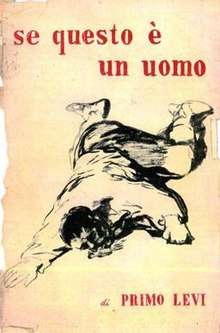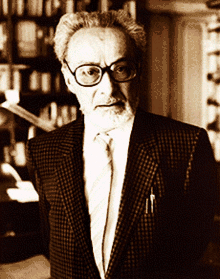If This Is a Man
 Original first edition cover | |
| Author | Primo Levi |
|---|---|
| Original title | Se questo è un uomo |
| Translator | Stuart Woolf |
| Country | Italy |
| Language | Italian |
| Genre | Memoir |
| Publisher |
De Silva (Italian) Einaudi (Italian) The Orion Press (English) |
Publication date | 1947 |
Published in English | 1959 |
| Pages | 179 pp |
If This Is a Man (Italian: Se questo è un uomo [se ˈkwesto ˈɛ un ˈwɔːmo]; United States title: Survival in Auschwitz) is a memoir by Italian Jewish writer Primo Levi, first published in 1947. It describes his arrest as a member of the Italian anti-fascist resistance during the Second World War, and his incarceration in the Auschwitz concentration camp (Monowitz) from February 1944 until the camp was liberated on 27 January 1945.
Background to the memoir
Primo Levi was born in 1919 in Turin. His forebears were Piedmontese Jews. He studied chemistry at the University of Turin, graduating cum laude in 1941, notwithstanding the restrictions imposed by Mussolini's racial laws. In 1942 he found a position with a Swiss drug company in Milan.[1] With the German occupation of northern and central Italy in 1943, Levi joined a partisan group in Valle d'Aosta in the Alps.[2] He was arrested in December 1943 and transported to Auschwitz in February 1944. He remained there until the camp was liberated on 27 January 1945.[3] If This Is a Man recounts his experiences in the camp.
Chapters
- The Journey
- On the Bottom
- Initiation
- Ka-Be
- Our Nights
- The Work
- A Good Day
- This Side of Good and Evil
- The Drowned and the Saved
- Chemistry Examination
- The Canto of Ulysses
- The Events of the Summer
- In October 1944 the prisoners anticipate a 'selection': the Germans will send a proportion of the prisoners to the gas chambers to make room for new arrivals. No one knows the exact day on which it will take place; the prisoners reassure each other that surely it will not be they who will be selected. When it comes, the process is so perfunctory that it is almost a matter of chance who is chosen.
- In Kraus Levi recalls the Hungarian working alongside him who has not grasped that in the camp hard work is not rewarded; not wasting energy is more likely to lead to survival.
- Winter has arrived. Die Drei Leute vom Labor ("The Three Laboratory People") describes how Levi and two other prisoners are chosen to work in the laboratory. Its cleanliness and warmth contrasts with the rest of the bomb-ravaged and snow-covered camp. The presence of three healthy women makes the prisoners self-conscious about their own physical deterioration.
- In The Last One Levi describes the audacious schemes he and Alberto devise to acquire goods to exchange for bread. At the end of the day the prisoners are assembled to witness the hanging of a man who has taken part in an uprising. At the moment of death he cries out "Comrades, I am the last!" The prisoners look on passively, robbed by now of any autonomy.
- Written in the form of a diary The Story of Ten Days is the work's epilogue. Suffering with scarlet fever, Levi is admitted to the camp hospital. By now the arrival of the Red Army is imminent and the Germans decide to abandon the camp. Only the healthy prisoners are evacuated. Alberto leaves, Levi remains. The forced march of the departing prisoners will take almost all of them, including Alberto, to their deaths. Levi and two other prisoners set about helping the other patients in their barrack, scouring the abandoned camp for provisions. The Soviet troops arrive on the 27th January 1945.
Composition
Levi began to write in February 1946, with a draft of what would become the final chapter recording his most recent memories of Auschwitz. According to Ian Thomson, Levi worked over the next ten months with concentrated energy and extreme facility. Levi told him that the words poured out of him 'like a flood which has been dammed and suddenly rushes forth'.[4] In the daytime Levi was working at a paint factory north-east of Turin. Mostly he wrote in the evenings and late into the night, although Levi said that the chapter The Canto of Ulysses was written almost entirely in a single, half-hour lunch break.[5] The first manuscript was completed in December 1946 and required considerable editorial work. His future wife, Lucia Morpurgo, helped him to shape the book, giving it a clear sense of direction.[6]
Publication
In January 1947, the manuscript was rejected by Einaudi. The writers Cesare Pavese and Natalia Ginzburg thought it too early after the war for such an account.[3] Levi managed to find a smaller publisher, De Silva,[7] who printed 2,500 copies of the book, 1,500 of which were sold, mostly in Levi's hometown of Turin. In 1955, Levi signed a contract with Einaudi for a new edition, which was published in 1958. The initial printing of 2000 copies was followed by a second of the same size.[8]
An English translation by Stuart Woolf was published in 1959. A German translation by Heinz Reidt appeared in 1961 (titled Ist das ein Mensch?) and a French edition in the same year.[7] All translations were completed under Levi's supervision. He was particularly careful to oversee the German translation, writing in The Drowned and the Saved: "I did not trust my German publisher. I wrote him an almost insolent letter: I warned him not to remove or change a single word in the text, and I insisted that he send me the manuscript of the translation in batches ... I wanted to check on not merely its lexical but also its inner faithfulness."[9]
Robert S. C. Gordon writes that Levi went on to develop a close relationship with Reidt.[10] The German edition contains a special preface addressed to the German people, which Levi said he wrote out of passionate necessity to remind them what they had done.[11] If This Is a Man is often published alongside Levi's second work of witness, The Truce (Italian title: La Tregua).
Invocation
The book is introduced by a poem. The construction "If .." invites the reader to make a judgment. It alludes to the treatment of people as Untermenschen (German for "sub-humans"), and to Levi's examination of the degree to which it was possible for a prisoner in Auschwitz to retain his or her humanity. The poem explains the title and sets the theme of the book: humanity in the midst of inhumanity.
The last part of the poem, beginning "meditate", explains Levi's purpose in having written it: to record what happened so that later generations will ponder (a more literal translation of meditare) the significance of the events he lived through. It also parallels the language of the V'ahavta, the Jewish prayer that commands followers to remember and pass on the teachings of their faith.
Style
The calm sobriety of Levi's prose style is all the more striking given the horrific nature of the events he describes. Levi explained in his 1976 Appendix to the work: "I thought that my word would be more credible and useful the more objective it appeared and the less impassioned it sounded; only in that way does the witness in court fulfil his function, which is to prepare the ground for the judge. It is you who are the judges."[12]
He ascribed the clarity of his language to the habits acquired during his training as a chemist: "My model was that of the weekly reports, a normal practice in factories: they must be concise, precise and written in a language accessible to all levels of the firm's hierarchy."[13]
Adaptation for Radio
In 1965 the Canadian Broadcasting Corporation aired the 140-minute dramatic feature, "If This is a Man", George Whalley's adaptation of Stuart Woolf's translation. The broadcast was produced by John Reeves, who has written about the radio production.
See also
Notes
- ↑ Levi 2015, vol.1, p.xxv–xxix.
- ↑ Levi 2015, vol.1, p.xxx.
- 1 2 Sands, Philippe (22 April 2017). "Primo Levi's If This is a Man at 70". The Guardian. Retrieved 26 July 2018.
- ↑ Thomson (2003), p.229.
- ↑ Thomson, pp.226 and 230—231.
- ↑ Thomson (2003), p.241.
- 1 2 Levi, Primo. Note to the Theatre version of If This Is a Man, pp. 23–25.
- ↑ Levi 2015, vol. 1, p.xxxix.
- ↑ The Drowned and the Saved, p. 139, cited in Gordon 2007, p.157.
- ↑ Gordon 2007, p. 157.
- ↑ The Drowned and the Saved (Italian title: I Sommersi e i Salvati)
- ↑ Levi 2015, vol.1, p.169.
- ↑ Levi 2015, vol.1, p.199.
Sources
- Benchouiha, Lucie (2006). Primo Levi: Rewriting the Holocaust. Troubador Publishing Ltd. ISBN 1-905237-23-5
- Gordon, Robert S. C. (2007). The Cambridge Companion to Primo Levi. Cambridge University Press. ISBN 0-521-84357-X
- Levi, Primo (2015). The Complete Works of Primo Levi. Penguin Classics. ISBN 978-0-713-99956-3
- Thomson, Ian (2003). Primo Levi: A Biography. Vintage. ISBN 0-09-951521-0
Further reading
- Alford, Frederick (31 May 2009). After the Holocaust: Primo Levi, The Book of Job, and the Path to Affliction. Cambridge University Press. ISBN 0-521-74706-6.
- Patruno, Nicholas (2008). Understanding Primo Levi. University of South Carolina Press. ISBN 1-57003-791-4.
- Pugliese, Stanislao G. (2004). The Legacy of Primo Levi. Palgrave Macmillan. ISBN 1-4039-6645-1.
- Farrell, Joseph (2004). Primo Levi: The Austere Humanist. Verlag Peter Lang. ISBN 3-03910-069-6.
- Angier, Carole (2003). The Double Bond: Primo Levi, a Biography. Penguin Books Ltd. ISBN 0-14-016587-8.
- Kremer, Roberta S. (2001). Memory and Mastery: Primo Levi as Writer and Witness. State University of New York Press. ISBN 0-7914-4922-X.
- Anissimov, Myriam (2000). Primo Levi: Tragedy of an Optimist. Overlook Press. ISBN 1-58567-020-0.
- Cicioni, Mirna (1995). Primo Levi: Bridges of Knowledge. Berg Publishers. ISBN 1-85973-063-9.
- Camon, Ferdinando (1991). Conversations with Primo Levi. The Marlboro Press. ISBN 0-910395-48-9.
- Vincenti, Fiora (1981). Primo Levi. Milan: Mursia.
External links

